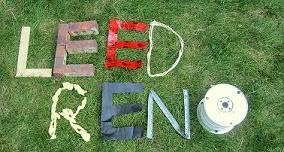Earlier when insulating behind the fireplace we used Touch n' Foam spray foam. At the time, the amount of waste bugged us but we were happy with the end product for the confined space we were working in. When the green rater performed the inspection, he commented that it has a limited net environmental benefit because of the blowing agent used.
 Fast forward a couple months and we are again presented with a space that is a good fit for spray foam. The joists in one section of our basement run parallel with the wall and directly in line with the inside edge. This creates a nice confined cavity that needs both vapour / moisture barrier and insulation.
Fast forward a couple months and we are again presented with a space that is a good fit for spray foam. The joists in one section of our basement run parallel with the wall and directly in line with the inside edge. This creates a nice confined cavity that needs both vapour / moisture barrier and insulation.I cannot see any practical way of getting in there to seal it off with caulk and a traditional vapour barrier. Improperly or poorly sealed it will allow moisture and drafts to get trapped in this pocket and come up through the living room floor. So I grab some more foam.
I already have a love/hate relationship with the foam and its throw away canisters. This is compounded by trimming away excess material that is going straight to the dump and the whole time this notion that the gas in the product is environmentally harmful is festering in the back of my mind as well. So I dig a little deeper into the accusation.
Pulling up the MSDS sheet, I find the blowing agent in question is a product called HFC-134a. The blowing agent is the compressed gas in the canisters that pushes the product out when I pull the trigger. It is also what gets trapped in the microscopic bubbles of the product and helps it insulate.
Pulling up its wikepedia page, I learn that it is relatively non-toxic and is the greener alternative to R-12, its ozone-destroying predecessor. All sounding good until I come to its Global Warming Potential (GWP). A gases GWP allows us to compare how much a gas contributes to the greenhouse effect. The scale is all based against CO2. A rating of one means it is as significant to global warming as releasing CO2. A rating of 2 would mean it is twice as harmful per kg. The rating for HFC-134a over a 20 year span is 3840!
12.89 kg package of spray foam,
20% HFC-134a by weight = 2.58kg
GWP= 3840
Holy Shit. I just sprayed the equivalent of 10 tonnes of CO2 into the atmosphere. For the second time on this project. As a comparison that is a year of heavy SUV driving and it only produced 200 board feet of insulation.
I am now reeling a little bit, surprised this product is even legal and worried I messed up my math. So I again turn to the web where I find an excellent article on GreenBuildingAdvisor.com. In the article, they look at various insulation types to determine how long it takes for that product to have a net positive impact on the global warming. i.e. how long until the energy savings resulting from your insulation upgrades offset the damage caused by your insulation. The bad news for spray foam: payback was in the order of 30 to 50 years and that was for professional application which is probably more efficiently applied.
 Their computations are riddled with assumptions causing some spirited discussions in the comments but no matter how you choose to massage that data, spray foam is a concern. But the article then proceeded to kick me when I was down. The other insulation suspected of having a high global warming potential? Extruded Polystyrene! The blue Styrofoam that I installed I throughout the kitchen (not to mention my last house). It will be 46 years before my kitchen starts to contribute positively to fighting climate change. My six year old will be finalizing his retirement plans by then.
Their computations are riddled with assumptions causing some spirited discussions in the comments but no matter how you choose to massage that data, spray foam is a concern. But the article then proceeded to kick me when I was down. The other insulation suspected of having a high global warming potential? Extruded Polystyrene! The blue Styrofoam that I installed I throughout the kitchen (not to mention my last house). It will be 46 years before my kitchen starts to contribute positively to fighting climate change. My six year old will be finalizing his retirement plans by then.For LEED? nothing. There is no reference, prerequisites or points associated with insulation blowing agents
Luckily, there are alternatives out there. The two prominent ones are expanded polystyrene (EPS) and polyisocyanate. Both of them use a much greener blowing agent and the same article I referenced before has their payback in the 2.7 to 4 year range. In the end I will probably try both those products out and write reviews on them. The replacement for those 39 sheets of XPS in the basement: Isolofoam which is an EPS product. It doesn't have quite the R value of EPS and requires a protective barrier to act as a vapour barrier but I can at least use it with a clear conscience.






